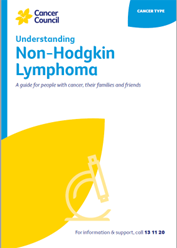- Home
- Non-Hodgkin lymphoma
- Treatment
- Stem cell transplant
- Steps in an autologous stem cell transplant
Steps in an autologous stem cell transplant
This is a general outline of a transplant using your own stem cells, but the process varies. The entire procedure, including recovery, can take months.
1. Stem cells stimulatedThe first step is to help the body make more stem cells. You’ll usually have a dose of chemotherapy followed by injections of a growth factor drug called granulocyte-colony stimulating factor (G-CSF) for 5–10 days. You can often have these injections at home.G-CSF helps the stem cells multiply and move out of the bone marrow into the blood. This process is called mobilisation and it takes several days. Blood tests will show whether your blood has made enough stem cells for collection. | |
2. Stem cells collectedStem cells are collected from your blood via a process called apheresis. You will have a needle called a cannula inserted into a vein in each arm, or you may need a special tube called a central venous access device surgically inserted into your chest, neck or groin.During apheresis, blood is taken from your body, passed through a machine to remove the stem cells, and then returned to your body. This commonly takes 3–5 hours and is usually done during a day visit to the hospital. | |
3. Stem cells preservedThe stem cells are frozen using liquid nitrogen. This is known as cryopreservation.You will have a rest period at home for about a month before the next step. | |
4. Conditioning treatmentIn the week before the transplant, you may have high-dose chemotherapy before the transplant. This aims to destroy any remaining lymphoma cells. It will also destroy the stem cells in your bone marrow, making room for new stem cells to grow.Side effects will be similar to those of standard chemotherapy but can be more intense. They may include nausea, diarrhoea, mouth sores, flu-like symptoms, lowered number of blood cells, and high risk of infections. | |
5. Stem cells transplantedA day or so after you have high-dose chemotherapy, your frozen stem cells are thawed and put back into your body (reinfused) using an intravenous drip. This process is similar to a blood transfusion and takes about an hour.You may have stomach cramps and feel sick (nauseous), which can be managed with medicines. You may also notice a “sweet corn” smell as the body flushes out the preservative used to freeze the stem cells. | |
 | 6. EngraftmentOver the next couple of weeks, the new stem cells will develop into new blood cells, allowing your bone marrow to recover. This is called engraftment.While the stem cells engraft, you’re at high risk of infection. In most cases, you will stay in hospital for 1–3 weeks until your blood counts have returned to safe levels and you’re well enough to go home. Once home, you’ll need check-ups every week or so. Over time, you’ll need check-ups less often. |
Talk to your transplant team about what to expect or contact the Leukaemia Foundation on 1800 620 420.
→ READ MORE: Palliative treatment
More resources
Dr Puja Bhattacharyya, Haematology Staff Specialist, Western Sydney Local Health District, Blacktown Hospital; A/Prof Christina Brown, Haematologist, Royal Prince Alfred Hospital and The University of Sydney; Dr Susan Carroll, Senior Staff Specialist, Radiation Oncology, Royal North Shore Hospital and The University of Sydney; Jo Cryer, Clinical Nurse Consultant, Haematology, St George Hospital; Marie Marr, Consumer; Katelin Mayer, Clinical Nurse Consultant, Cancer Outreach Team, Nelune Comprehensive Cancer Centre, Sydney; Vanessa Saunders, 13 11 20 Consultant, Cancer Council NSW; Elise Toyer, Haematology Clinical Nurse Consultant, Blacktown Hospital.
View the Cancer Council NSW editorial policy.
View all publications or call 13 11 20 for free printed copies.



